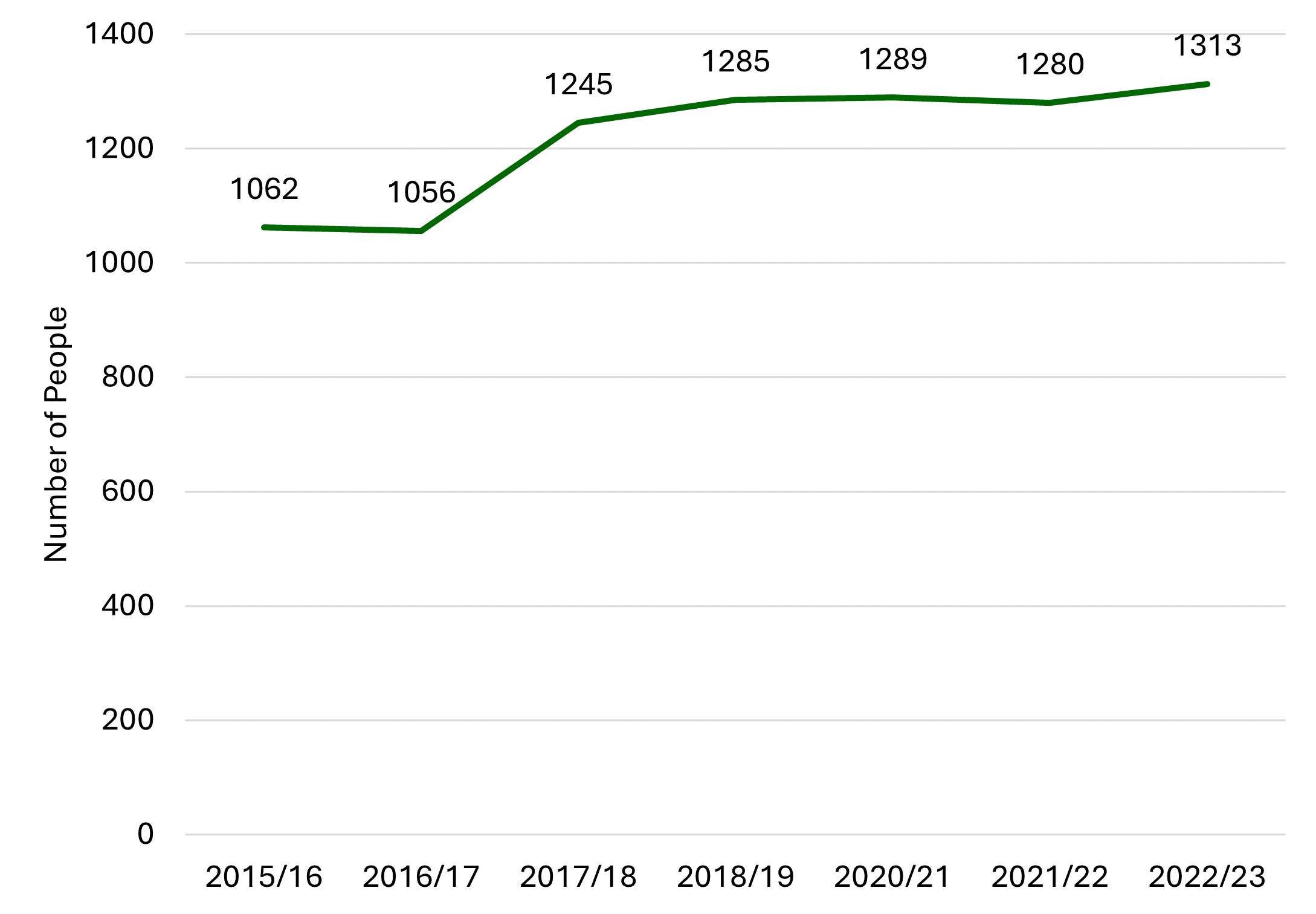Adult Social Care - Data
What you told us
What the data tells us
Adult Social Care relates to the assessment of care and support needs and provision of support across all adult and older people client groups. It comprises of the following field work staff: Social Workers (includes Mental Health Officers), Occupational Therapists, Community Care Assistants, and team leaders.
76% of people who are in receipt of support said it helps them live independently 82% staff agree with this.
80% of people and staff believe the support provided helps people feel safe.
65% of people who receive support at home and 43% of staff believe that support is provided at the right time.
There are almost double the number of referrals for those aged 65+ compared to those under the age of 65 (Midlothian Health and Social Care Partnership; Strategic Plan Consultation, 2019)
Number of referrals to adult social work (Social Work, Community OT and Community Care Assistants)
Data source: Midlothian Council internal data. Mosaic. (Note: this is the number of referrals made, not the number of individuals involved. An individual can have multiple referrals).

In 2018 the average wait time between referral and assignment to a worker was 22 days (Mosaic; Midlothian Council, 2018). Referrals are screened based on urgency. Those requiring an Adult Support and Protection response must be assigned to a Council Officer within 24 hours and other urgent referrals are assigned within a short timescale, therefore the difference between the shortest and longest wait is large (longest wait can be several months).
The reducing numbers of referrals and average wait time for Adults and Social Care correlates with the promotion of realistic care, realistic expectations. As this is two year’s data it is not clear whether this is a continuing trend but the reasons behind this may warrant further analysis and consideration.
Day Opportunities
There is one learning centre for adults with complex learning disabilities based in Bonnyrigg open Monday – Friday.
The Community Access Team supports adults with Learning Disabilities through programmes of activities in 5 community hubs (2 in Mayfield, 1 in Penicuik, 1 in Dalkeith, 1 in Lasswade).
There are 4-day centres for older people, one of which is dementia specific. Many day opportunities are run or supported through the third sector such as Local Area Co-ordination and Befriending.
People also use self-directed support to build personalised and creative day opportunities.
Residential care
Over 65
The private sector is the largest provider of care homes for older people. The voluntary sector provides proportionally more care home places in Midlothian than in Scotland as a whole. There is a move to support more people at home with complex needs.
Residential Care Provision - Homes
Data Source:Midlothian Council Internal Data (31st March 2023)
| Local Authority | Private/Voluntary | Total | |
| Midlothian | 2 | 9 | 11 |
| Lothian | - | 39 | 39 |
| Other Areas | - | 23 | 23 |
| Total | 2 | 71 | 73 |
| Total 2021-22 | 2 | 79 | 82 |
| Total 2020-21 | 2 | 77 | 79 |
| Total 2019-20 | 2 | 76 | 78 |
| Total 2018-19 | 2 | 78 | 80 |
Residential Care Provision - Residents
Data Source:Midlothian Council Internal Data (31st March 2023)
| Local Authority | Private/Voluntary | Total | |
| Midlothian | 101 | 356 | 457 |
| Lothian | - | 129 | 129 |
| Other Areas | - | 26 | 26 |
| Total | 101 | 511 | 612 |
| Total 2021-22 | 114 | 490 | 604 |
| Total 2020-21 | 119 | 548 | 667 |
| Total 2019-20 | 121 | 586 | 707 |
| Total 2018-19 | 112 | 544 | 656 |
Care at Home
Most people in receipt of care at home are 65 and over. Personal care is non chargeable for people with an assessed need. The intensity of demand for Care at Home services requires skilled coordination as home care must flex around the daily changing lives of people, hospital & GP appointments, family, unpaid carers, day care, holidays, sickness etc. There are known challenges with capacity, recruitment, and retention in care at home specific to older people. These challenges are more pronounced in the independent sector where terms and conditions of employment differ.
Assessed requests for Care at Home support are screened based on urgency and need. This includes hospital discharge referrals. Some people wait a long time for a consistent care provider or package of care. Self-directed support enables people to exercise choice and control over their care but with this comes the additional challenge of balancing this with the ability to meet the needs of as many people as possible.
Number of people receiving care at home services
Data source: Midlothian Council

Average hours of care received by an individual weekly
Data source: Midlothian Council

As our largest population increase is predicted to be in those aged 75 and over (see demographics section) the challenges of providing care at home will increase. This requires a whole system approach and response involving communities and all sectors of care to better support people to live well in the surroundings and with the care they choose. The further exploration of the use of technology to collaboratively respond to both planned and unplanned need is also recognised as important.
The link between the sudden increase in numbers of older people moving to care homes and capacity challenges in Care at Home warrants further exploration. The impact on systems, assessment and supports of the introduction of free personal care for those under 65 with an assessed need also needs further exploration.
Page updated October 2024
